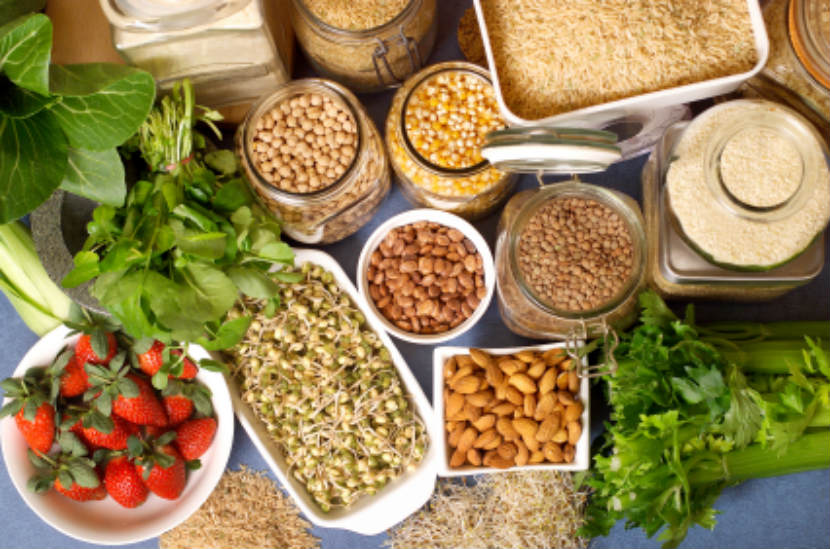
A vegan is a type of vegetarian that avoids all animal products. This means that a vegan does not eat meat, milk, dairy products or eggs. However, a vegan eating pattern can still contain all of the important vitamins and minerals that your body needs. It just takes planning!
If you are thinking about becoming vegan or want to eat fewer foods from animal sources, here are four key tips you need to know. And before you remove all animal products from your diet, make sure to speak with your doctor, healthcare provider or dietitian to make sure a vegan eating plan is right for you.
1. Get enough protein
Vegans don’t eat meat, fish, poultry, dairy and eggs. These foods are high in protein, which is important for red blood cells and muscles. Vegans need to replace animal protein with plant protein sources such as:
-
Soy and soy products: tofu, edamame (green soybeans), fortified soy beverages
-
Meat alternatives: textured vegetable protein (TVP), veggie burgers, veggie hot dogs
-
Legumes: lentils, dried peas and beans
-
Whole grains: quinoa, buckwheat
-
Nuts and seeds: almonds, walnuts, cashews, sesame seeds, flax seeds
2. Remember omega-3 fats
Omega-3 fats are important for heart health and for brain and eye development in infants. Non-animal sources of omega-3 fats are:
-
Oils: canola, flax seed, walnut and soybean
-
Soybeans and tofu
-
Ground flax seed and walnuts
Some foods like soy beverages, bread and orange juice may be fortified with omega-3. Read the label and ingredient list to see if the food has the nutrients you need. For help with reading labels, watch these videos.
3. Make sure to get the vitamins you need
Vitamin B12
Vitamin B12 helps keep the body’s nerves and blood cells healthy. Vitamin B12 is found only in animal foods and fortified foods, such as:
-
Fortified beverages made from soy, almonds or rice
-
Red Star nutritional yeast
-
Fortified meat alternatives: TVP, veggie burgers (check the label)
Vegans may need to take vitamin B12 supplements. Before choosing a supplement, speak with your doctor, healthcare provider or Registered Dietitian to figure out how much you need.
Vitamin D
Vitamin D helps the body absorb calcium. Our bodies naturally make vitamin D from the sun’s rays. However, wearing sunscreen or clothing that covers most of the skin can limit how much vitamin D you produce. There are also not many vegan sources of vitamin D. You can get vitamin D from:
-
Soft margarine
-
Fortified beverages: soy, almond, rice drinks (check the label).
Some vegans choose to take vitamin D supplements. Before choosing a supplement, speak with your doctor, healthcare provider or Registered Dietitian to figure out how much you need.
4. Make sure to get the minerals you need
Calcium
Calcium keeps bones healthy and regulates heart and muscle contractions. Vegans often don’t get enough calcium. Include these vegan sources of calcium in your diet:
-
Fortified beverages: soy, rice or almond beverages
-
Calcium-set tofu
-
Legumes: kidney beans, baked beans, navy beans
-
Almonds, almond butter
-
Sesame seeds
-
Blackstrap molasses
-
Dark green vegetables: broccoli, kale, collards
Iron
Iron helps carry oxygen around the body. Vegans need twice as much iron as people who eat meat. This is because we don’t absorb the iron in plant foods as well as the iron in animal foods. Vegan sources of iron include:
-
Legumes: kidney beans, black eyed peas, red lentils
-
Blackstrap molasses
-
Soy products: tofu, fortified soy beverages, veggie burgers, TVP
-
Fortified pasta and cereals
-
Dried fruit: prunes, raisins and apricots
-
Dark green vegetables: collards, okra, bok choy
-
Quinoa
Tip: To help your body absorb iron, eat iron-rich foods with a source of vitamin C. Examples of vitamin C-rich foods are strawberries, broccoli and oranges. It is also a good idea to save coffee and tea for after meals because some compounds in these drinks affect how you absorb iron.
Zinc
Zinc plays a role in wound healing and helps the immune system fight off viruses. Vegan sources of zinc include:
-
Legumes: lentils, refried beans, lima beans
-
Soy products: tofu, fortified soy beverages
-
Nuts and seeds: peanuts, peanut butter, sesame seeds, tahini, pumpkin seeds, cashews
-
Grain products: wild rice, wheat germ
A vegan eating plan can work for everyone with some planning
People at any age or stage – from babies to older adults – can follow a vegan eating plan. The important thing is to make sure you get all the nutrients you need for good health, and if your child is vegan, to make sure they get the nutrients and energy they need to grow and develop well.
If you’re pregnant or breastfeeding, make sure to include sources of vitamin B12, iron and omega-3 fatty acids. Speak to your doctor, healthcare provider or Registered Dietitian about a prenatal supplement.
If you’re over age 50, you will need a little more calcium, vitamin D and vitamin B12. You may also want to talk to your doctor, healthcare provider or Registered Dietitian about food choices and supplements.
Not matter your age, make sure to follow Canada’s Food Guide and speak to your doctor, child’s paediatrician, healthcare provider or Registered Dietitian about a vegan eating plan that will work for you.
Bottom line
Knowledge is key when planning a vegan diet. Talk to a health professional for more information.
You may also be interested in:
What you need to know about following a vegan eating plan
What you need to know about a vegetarian eating plan
What you need to know to raise a healthy vegetarian child
Last Update – January 3, 2019